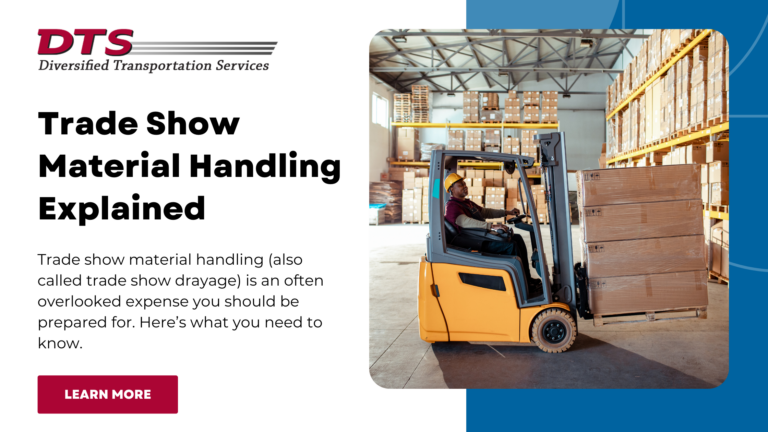
There’s an awful lot to learn when it comes to trade show shipping. From pre-show preparation to identifying crucial trade show contacts, knowing the ins and outs of trade show shipping can help you have a smooth experience while keeping those costs down.
One expense that catches many out is trade show material handling. This is an often overlooked expense but an essential one to be familiar with. Let’s look at what trade show material handling is and why it can come with such a hefty price tag.
Trade show material handling, also called trade show drayage is the process of moving your trade show booth items and materials from the shipping carrier’s delivery vehicle or the advance warehouse to your booth. If you think of the trade show as a concert, this would be the equivalent of venue staff helping load gear into the venue from the band’s trailer.
Trade show material handling covers a range of activities, including:
Then, at the end of the trade show, they’ll return your packing materials and do the whole thing in reverse.
Trade show drayage is an incredibly helpful service that allows you to worry less about building and logistics. However, it’s often quite expensive and tends to be a separate charge from the rest of your trade show shipping costs. Sometimes, it can even cost more than shipping all your goods from your headquarters to the trade show.
When shipping your trade show materials, you can shop around and see which carrier fits your needs and your budget. Unfortunately, that’s not something you can do when it comes to trade show material handling.
Trade show drayage is exclusively handled by the general contractor the organizer has chosen. This means they can set the price for this service, and you simply have to pay it because the organizer won’t allow third parties to get involved.
While this can be inconvenient, leaving jobs like this to one general contractor means the trade show can run exactly as planned. Allowing a range of third-party contractors to handle materials could result in miscommunication, delays, and disruption.
Head to our blog to learn more about trade show shipping key players like general contractors and trade show organizers.
Trade show drayage fees are calculated using the weight of your materials, the number of pieces you have, when your materials will arrive, if there are any special requirements, and if the materials can easily be moved.
Standard fees are calculated based on CWTs or weight per 100 pounds. Basic drayage rates within the US are typically between $60 and $160 per CWT. However, your quote will change if you bring specialized equipment or valuable items to display at your booth. These incur a higher fee than a traditional trade show booth because the general contractor will need to provide a more tailored service.
While you can use the typical trade show drayage rate as a guide, it’s hard to guess your final cost for your booth too long before the event. However, there are steps you can take to keep your trade show material handling fees down.
Trade show material handling is just one of many confusing and potentially expensive parts of trade show shipping. If you’re left scratching your head, consider partnering with a trade show shipping company like DTS. We can help you prepare for everything from trade show drayage to paperwork.
Whether you're a company looking to improve one facet of your supply chain, your entire supply chain, or simply looking for a transportation and logistics consultation, we can help.